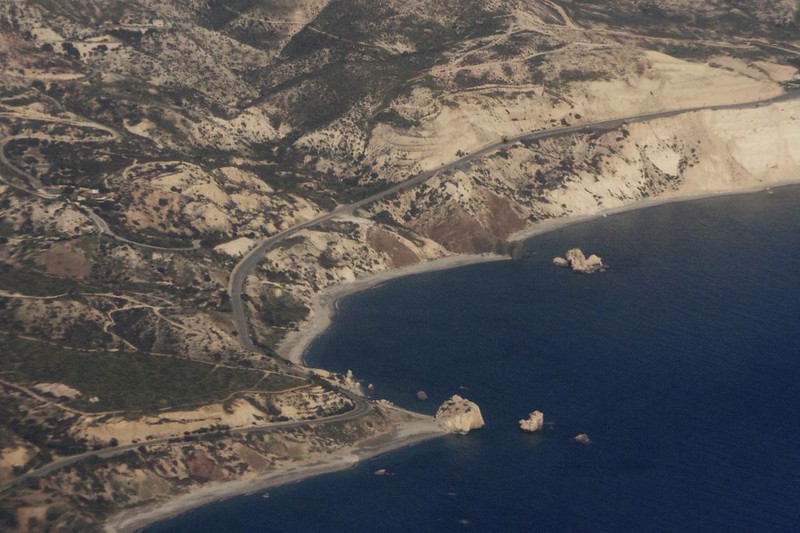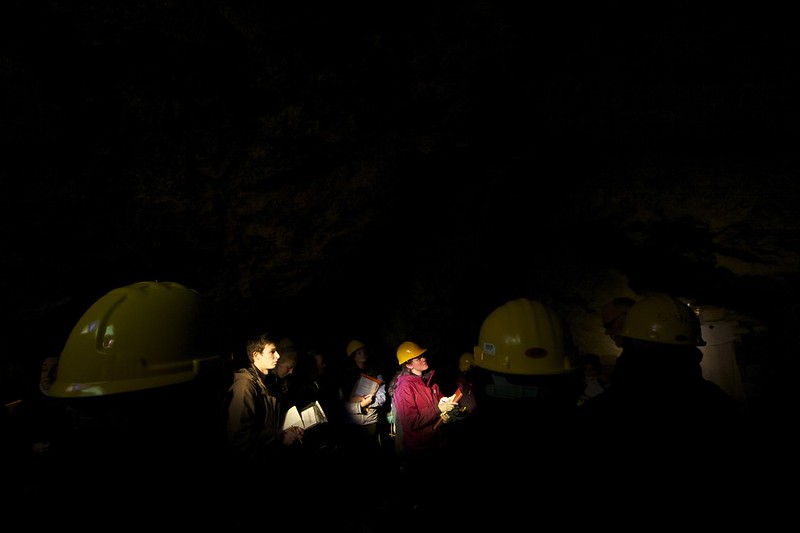Well, what a day. The third field day of the @GeologyHull 3rd year fieldtrip to Cyprus, and after a meander in the Mamonia (most mesmerizing) and a tramp through the Troodos (truly tectonized), we set our sights on the circum-Troodos sedimentary cover.
As is always wise, we began the day in a locality that none of us had ever visited before. Now known as Mudbath Bay due to a particularly welcoming kaolinitic puddle on the edge of the beach, this little beach just east of Petra tou Romiou was apparently a great place to see the Lefkara Formation. And indeed it was. The chalks were full of trace fossils, and examination under a hand lens showed the thin, coarser beds between them to be foraminiferal grainstones, jam-packed full of this splendid little beast. We had particular fun trying to work out how many chalk coccolithophores you could fit inside one foram*.
I speculated wildly about what was going on, sedimentologically and palaeoenvironmentally, and then split the group in two. Team Liam headed a short way up the B6 road to look at the Lefkara Formation slightly higher up, and Team Cian went onwards and upwards, to try and find the Pakhna Formation. The challenge for each team was to produce a summary of the sedimentology of their site, which would then be read out to the other team, who hadn't seen it. A member of that team would then try and draw their log for them, on pieces of magic whiteboard slapped to the side of the bus, in an exciting new form of Pictionary.
It was hot, it was sunny, and the roadcut reconnaissance was made mildly perilous by the cars and cyclists bombing down the hill towards the sea**. Thankfully, we made it through our allocated time without incident and reconvened in the layby, ready for our sedimentology-by-proxy exercise. First Cian tried to draw Team Liam's observations up as a log, then I attempted the reverse. This is what we ended up with:
Back on the bus, we drove past the Pakhna, not to mention the Kalavasos and Lago Mare formations, before descending into Pissouri Bay. Some delicious refreshment was had there, whilst a chap at the bar told us that some of the new-build houses in the bay were sinking by 2cm a year, their foundations not being piled into bedrock. We were offered the chance to do some engineering geology, but had to politely decline, as it was time to visit the nudist beach.
The rocks at the eastern end of Pissouri Bay are of interest to all naturists, but sadly the bivalve shells so abundant in the lithified beach deposits were not rudists. They're probably veneroids of some kind, but I didn't look very closely. Instead I was - like most of our group - bewitched by the cross-bedded sedimentology of the boulders that have fallen from the cliffs above. They are what I dubbed trooditic bioclastic calcirudites - very coarse-grained sedimentary rocks packed full of shelly debris, but with a wide array of ophiolitic clasts too.
Also snaking their way into the picture were specimens of the trace fossil Ophiomorpha, making a guest appearance in the ?Pliocene sands and muds that form the unstable cliffs upon which the trooditic calcirudites perch. With a bit of assistance, the students concluded that this was a coarsening-upwards succession, representing an offshore-to-onshore transition. But why were ancient beach deposits at the top of a cliff?
To seek answers in the late afternoon, we moved onto St Spiridon's Chapel, which also just happens to be a sea cave about 27 metres above present-day sea-level. Looking at the rock exposed inside the chapel, it seems to be a very large, cemented, sand dune, but we agreed it would probably be unethical to whack a lump of it off with a hammer to confirm this.
Instead, we finished the day with another scalar change, from sermonizing in a sea cave to scanning the horizon from the top of Pissouri Hill. Getting a coach up it was fun, so our splendid driver Savvas decided he might as well make it even more so, and did the last bit in reverse. Almost immediately, the police arrived, but this might just as well have been due to a call from the local neighbourhood watch, demanding that this busload of hi-vis miscreants be cleared off their estate.
And as we gazed out across the landscape, wondering about uplift and erosion and sea-level change and sedimentation, the Troodos looming gloomily in the distance, it was hard not to think that this really was the life.
Whatever will tomorrow bring...?
 |
| A bird's eye view of Petra tou Romiou, Cyprus. |
As is always wise, we began the day in a locality that none of us had ever visited before. Now known as Mudbath Bay due to a particularly welcoming kaolinitic puddle on the edge of the beach, this little beach just east of Petra tou Romiou was apparently a great place to see the Lefkara Formation. And indeed it was. The chalks were full of trace fossils, and examination under a hand lens showed the thin, coarser beds between them to be foraminiferal grainstones, jam-packed full of this splendid little beast. We had particular fun trying to work out how many chalk coccolithophores you could fit inside one foram*.
| The spherical planktonic foraminiferan Praeorbulina (probably not the right species, but what the heck) Image by H. Hayashi (source: http://rin.hiroba.org/foraminifera/circularis.html) |
I speculated wildly about what was going on, sedimentologically and palaeoenvironmentally, and then split the group in two. Team Liam headed a short way up the B6 road to look at the Lefkara Formation slightly higher up, and Team Cian went onwards and upwards, to try and find the Pakhna Formation. The challenge for each team was to produce a summary of the sedimentology of their site, which would then be read out to the other team, who hadn't seen it. A member of that team would then try and draw their log for them, on pieces of magic whiteboard slapped to the side of the bus, in an exciting new form of Pictionary.
It was hot, it was sunny, and the roadcut reconnaissance was made mildly perilous by the cars and cyclists bombing down the hill towards the sea**. Thankfully, we made it through our allocated time without incident and reconvened in the layby, ready for our sedimentology-by-proxy exercise. First Cian tried to draw Team Liam's observations up as a log, then I attempted the reverse. This is what we ended up with:
 |
| It's a phone photo, it's rubbish. But is the geology any good...?*** |
Back on the bus, we drove past the Pakhna, not to mention the Kalavasos and Lago Mare formations, before descending into Pissouri Bay. Some delicious refreshment was had there, whilst a chap at the bar told us that some of the new-build houses in the bay were sinking by 2cm a year, their foundations not being piled into bedrock. We were offered the chance to do some engineering geology, but had to politely decline, as it was time to visit the nudist beach.
 |
| Plio-Pleistocene geology in Pissouri Bay: the naked truth |
The rocks at the eastern end of Pissouri Bay are of interest to all naturists, but sadly the bivalve shells so abundant in the lithified beach deposits were not rudists. They're probably veneroids of some kind, but I didn't look very closely. Instead I was - like most of our group - bewitched by the cross-bedded sedimentology of the boulders that have fallen from the cliffs above. They are what I dubbed trooditic bioclastic calcirudites - very coarse-grained sedimentary rocks packed full of shelly debris, but with a wide array of ophiolitic clasts too.
 |
| Cyprus geology in pebbles (photo by @GeologyClare) |
Also snaking their way into the picture were specimens of the trace fossil Ophiomorpha, making a guest appearance in the ?Pliocene sands and muds that form the unstable cliffs upon which the trooditic calcirudites perch. With a bit of assistance, the students concluded that this was a coarsening-upwards succession, representing an offshore-to-onshore transition. But why were ancient beach deposits at the top of a cliff?
To seek answers in the late afternoon, we moved onto St Spiridon's Chapel, which also just happens to be a sea cave about 27 metres above present-day sea-level. Looking at the rock exposed inside the chapel, it seems to be a very large, cemented, sand dune, but we agreed it would probably be unethical to whack a lump of it off with a hammer to confirm this.
 |
| Reverence in sanctity. |
Instead, we finished the day with another scalar change, from sermonizing in a sea cave to scanning the horizon from the top of Pissouri Hill. Getting a coach up it was fun, so our splendid driver Savvas decided he might as well make it even more so, and did the last bit in reverse. Almost immediately, the police arrived, but this might just as well have been due to a call from the local neighbourhood watch, demanding that this busload of hi-vis miscreants be cleared off their estate.
 |
| The view from Pissouri hill. |
And as we gazed out across the landscape, wondering about uplift and erosion and sea-level change and sedimentation, the Troodos looming gloomily in the distance, it was hard not to think that this really was the life.
Whatever will tomorrow bring...?
*This GIF of a bacterium on a diatom on an amphipod gives you an idea.
**They were not lemmings. The road just went down towards the sea, before veering back up and along the coast.
***Spoiler: yes. The students did a good job of trying to summarize some confusing contourites.
Comments